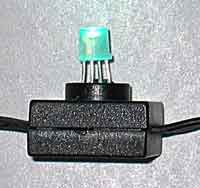TRIKLITS Details


Physical
The light string has a 12 foot lead-wire between the control box and the first light.
The spacing between the center of each light is 250mm (about 10 inches).
The balls are 40mm (1.6 inches) in diameter. The power supply has a 2m (6 foot) cable.
Do not squeeze the plastic balls as this will leave permanent bend marks
on them.
The plastic balls are removeable if you want to use the strings for
other lighting applications. This will expose the top of the LEDs.
Note that we use a flat-top LED with no lens, to get the widest
viewing angle of light. They are not pretty to look at bare. You
will need some kind of diffuser to cover them with. For space limited
applications, you could remove the circuit boards from the black pastic case,
but this is difficult and not recommended.
Weather Resistance
The power supply and control box must be kept in a dry location. The
lights are rain-proof ONLY if they are strung horizontally with the
balls facing downwards. For other orientations you could glue the
balls into their sockets, but we have not tried this yet.
We recommend trying a glue called Household Goop. If water does
get into the lights, turn them off, maybe remove the balls, and
let them dry out for many days before applying power again.
Power
The power supply is a UL listed switching
wall transformer, input range is 100-120vac 50-60hz,
output is 9vdc at 1500ma.
The power input jack on the control box is a 5.5/2.1mm coax jack (center positive).
The lights can run from a supply voltage of 9-12vdc.
If you connect your own power supply, make sure you do not hook it up
backwards, as this will instantly destroy the lights.
If you want to run a string from a battery, you will need a 12v battery.
A 12v 7AH sealed lead-acid battery should run the lights an entire night,
maybe 10-12 hours. How long the battery lasts will depend highly on the
patterns selected. A color rainbow pattern will use 800-1000ma.
Only full white on all lights will use near 1500ma. When the lights are
all off (or in soft-power down mode) the string uses about 80ma.
Here is more info on powering Triklits from a battery.
External Control
Every light can be set to a 24-bit color up to 50 times per second.
The interface to control the lights externally is via an RJ-11 jack
and RS-485 interface running a custom protocol. The lights are sent a
frame of new color data and they all update simultaneously at the end
of the frame. The two middle pins of the RJ-11 jack are the RS-485
data wires, and the two outside pins are ground. The controller auto-detects
polarity on the data wires. RS-485 is used because it allows
control across very long wires. Note that there is no termination in
the control box and this may need to be added externally for
certain configurations.
It is also possible to cut off the control box from the string of
lights, and feed power and a TTL level data signal (same protocol as
the RS-485 link) directly to the lights. The center wire is ground
and the outer wires are power (9-12vdc) and data. You will have to
figure out which is which by opening the control box and tracing the
connections (if you get this wrong and put 9v on the data line you
will destroy the lights!). The data signal needs a high current
driver (25ma source and sink), such as the output pin from a PIC or a
74ACT574 chip. You should put a 2000 ohm resistor in series between
the driver chip and the light string.
Protocol
A description of the
Triklits protocol
can be found here.
Colors and Power
The color of the three LEDs is not matched to provide an even white
color when they are all the set to the same value. We purposely used
a higher brightness Red LED so that the three colors have a more even
brightness to them when viewed individually. So to get white, or to
more correctly display RGB values from other sources (such as a PC), you
may need to scale down the red value.
The highest recommended power level for each light is around 100mW.
Exceeding this may shorten the life of the LEDs or reduce their brightness.
You can compute the approximate power used for values of R,G,B as follows:
mW = (R/255)*38 + (G/255)*65 + (B/255)*65
For continuously on white we suggest an rgb value around (72,152,160). If you
pulse the LEDs for short periods, you can use higher values. However,
higher values may also exceed the capability of the included power supply.

